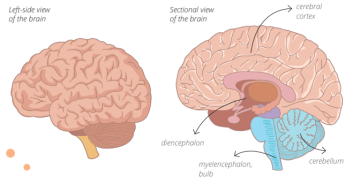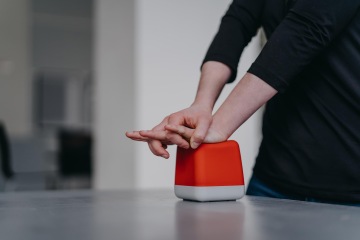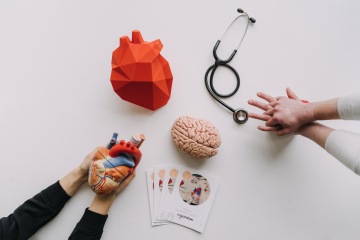Brain and stroke
A brain is a part of central nervous system, responsible for the coordination and proper function of the entire body.
What can the brain get sick of?
Stroke is a state, during which an artery supplying brain with blood and oxygen becomes blocked. It is most often a result of atherosclerosis.

How does a stroke manifest itself?
BE FAST!

- Balance - loss of balance
- Eyes - vision problems
- Face - asymmetric face, numbness, tingling
- Arms - numbness, tingling
- Speech - Speech, problems with speech
- Time - If you experience any of these symptoms or if you see someone else experiencing them, call 155 immediately! Stroke doesn't hurt, that's why it's dangerous.
How to prevent a stroke?
Preventable risk factors:
- Smoking - If you quit smoking, the risk of having a heart attack or stroke lowers by up to 50%.
- Lack of exercise - Exercise regularly, at least 5 times a week for 30 minutes.
- Sleep - Sleep for at least 7 hours a day and go to bed (and from it) at the same time every day (yes, even at weekends :) )
- Diabetes - If you have diabetes, get checked by your doctor regularly.
- Blood pressure - If you have high blood pressure, check it regularly and take your pills.
Non-preventable risk factors:

- Gender - Men are more prone to both heart attack and stroke, women are more protected thanks to their sex hormones - estrogens.
- Age - The risk of having a stroke or a heart attack is higher after you turn 55.
- Genetics - If someone from your family had a stroke before the age of 55, tell that to your GP. Familial hypercholesterolemia, for example, is a hereditary disease, which can manifest at a young age.
FAQs
What to do when...
5 important steps to do when you have or see someone else having a heart attack or stroke.
- Don't panic, don't look for advice on the internet and start acting!
- Call 155 for help!
- Stay where you are and wait for an ambulance
- Is the patient conscious? Shoothe him/her. Check breathing and reactions (talk, pinch the patient's ear)
- Is the patient unconscious? Check breathing - tilt the patient's head back and see, if the chest is moving up and down. If the patient is not breathing, start chest compressions immediately!
What are the most common risk factors?
- Insufficient physical activity
- Obesity
- Unhealthy diet high in salt
- Alcohol consumption
- Smoking
Is it true that smoking is harmful to health?
Yes, of course. Smoking:
- increases the risk of blood clots
- disrupts platelets' function
- increases the number of white blood cells
- reactive oxygen species are being produced and further damage the surface of blood vessels

